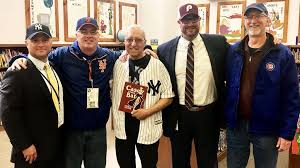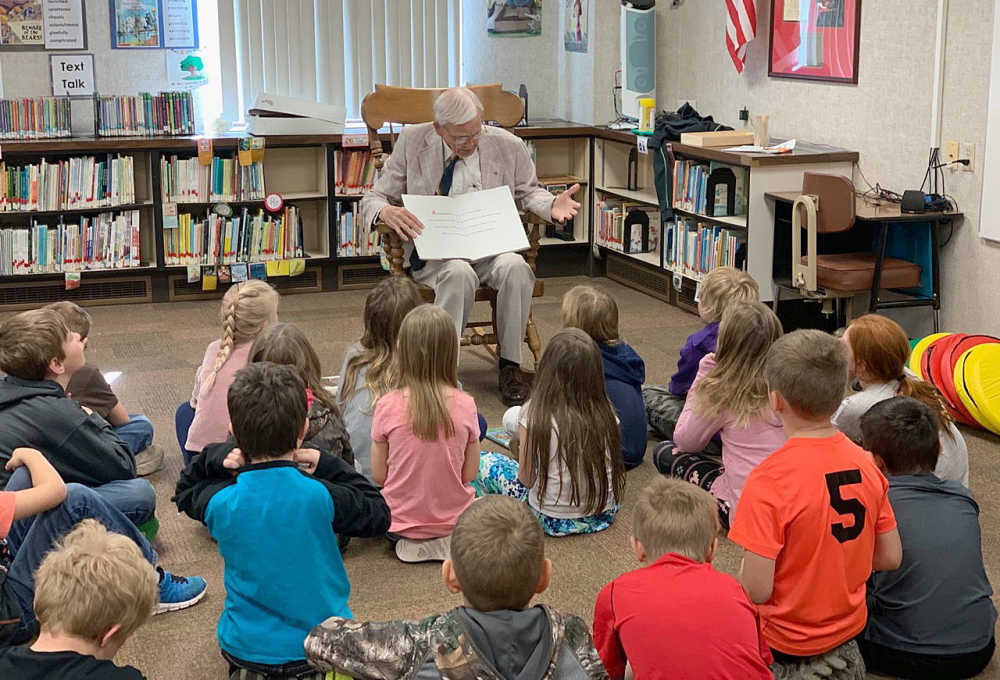
Wayne County Wanderings: Casey at the Bat
Renowned classicist Bernard Knox (1914-2010) reminded us that the notion in Western culture of "looking forward" from the present into the future, which had awakened only in medieval times, is not the only way to imagine ourselves in relation to the future.
The Greek word opiso, which means 'behind' or 'back,' refers not to the past, but to the future. The early Greek imagination envisaged the past and the present as in front of us--we can see them. The future, invisible, is behind us. Only a very few wise men can see what is behind them; some of these men, like the blind prophet Tiresias, have been given this privilege by the gods. The rest of us, though we have our eyes, are walking blind, backward into the future.[1]

Homer Singing His Iliad at the Gates of Athens, by Guillaume Lethiere (1760-1832), Courtesy Nottingham Castle Museum and Art Gallery
Following for your enjoyment is Kevin Edwards' unedited column:From the Wayne Independent, in Honesdale, Pennsylvania (April 19, 2019) comes Kevin Edwards' Wayne County Wanderings: Casey at the Bat . Caseyatthe.blog could not improve on this example of timeless Americana. It reminds us of the way one generation shares its memories with another through the oral tradition of folk tales and heroic ballads--a tradition harking back to Homer and the Iliad. I treasure from Edwards' inter-generational narrative the hope that the newest generation--by "looking back"--can not only thrill to the classics in the same way that their elders once did--but may also learn the ancient art of discovering the future by interpreting the past!
Honesdale High School legend Pete Ruvolo revives a much-loved tradition The year is 1983. I am a junior in high school and the world is an interesting place. President Ronald Reagan proposes the Strategic Defense Initiative, also known as Star Wars. Mario Brothers is first released by Nintendo to the delight of video game fans everywhere. The final episode of the iconic TV series M*A*S*H is watched by a record 125 million viewers. Meanwhile, here in Honesdale, a much-loved high school teacher strides into his 11th grade English class. He wears a jacket and tie as usual, but something is different on this particular day.

Educator Pete Ruvolo, in a 2010 interview with Kevin Edwards, confided "I like baseball and poetry. I believe poetry should have a meaning to us individually and this poem speaks to me. This poem is a metaphor saying it’s ok to fail. Although we’d like to come through all the time, we have to accept it and get it next time."
He closes the door and stands in front of his desk, a smile on his face, hands clasped behind his back. It takes a minute before the classroom settles down. Eventually, all the chitchat, whispers and banter subside. Silence reigns. A roomful of curious students stares straight ahead expectantly. The teacher smiles. From behind his back he produces a rumpled New York Yankees cap and places it on his head. From his jacket pocket, he pulls out a baseball.The date is Monday, April 4. It’s Opening Day of the 1983 Major League season and Pete Ruvolo is about to embark upon an annual tradition. He clears his throat, holds the horsehide out in front of him dramatically and begins to recite in a strong, clear voice. “The outlook wasn’t brilliant for the Mudville nine that day...”
Fast Forward
The year is 2019. I’m in my 25th year of covering the Wayne County Sports scene. High school is a distant memory, but the world remains an interesting place. President Donald Trump is dealing with the release of a 400-page investigative report by Special Counsel Robert Mueller. Mario Brothers has long faded from public consciousness, replaced by games like Call of Duty, Grand Theft Auto and Red Dead Redemption. While M*A*S*H will live on forever in re-runs, Game of Thrones dominates conversation around the water cooler these days.Meanwhile, it’s Tuesday afternoon at Lakeside Elementary School and a group of third graders has assembled in the library. There’s a palpable sense of excitement in the air as these lucky boys and girls prepare for a rare treat. Standing off to the side is an equally excited group of adults, all of whom have gathered to show their support. Superintendent Greg Frigoletto sports his Yankees hat. Assistant Superintendent Tim Morgan wears a retro Phillies cap and retired teacher Dick Roberts is dressed from head to toe in Cubs attire.
These three, along with Pete, comprise the legendary “Tour Four,” a quarter of baseball buddies that’s made it their mission to see a game together in every Major League stadium. This summer, they’re planning to hit Citi Field in New York and Citizens Bank Park in Philly. “He’s such a great guy,” Tim says. I’d be hard-pressed to name anyone as kind, optimistic and wise as Pete.” Librarian Robin Sampson and Lakeside Principal Sandy Rickard happily oversee the situation. “Mr. Ruvolo is a legend and we’re just thrilled that he can be here,” Sandy says. “This is like a flashback for me. I had him as a teacher and it doesn’t seem like he’s changed at all.”
It takes a few minutes for the third graders to wind down, but Pete is patient. He has an uncanny sense of timing and delivery. “I’ve been reciting this poem for a very long time boys and girls,” he says. “And today I’d like to share it with you.” The students settle in. They’re seated on the carpeted floor, looking up wide-eyed and expectant as Pete begins. “The outlook wasn’t brilliant for the Mudville nine that day...”
The Origin
“Casey at the Bat, A Ballad of the Republic” was written by Ernest Lawrence Thayer in 1888. It first appeared in print on June 3 in the The San Francisco Examiner and was rapturously received. The poem is loosely based on an actual player, but as with all creations of bona fide genius, its appeal is transcendent. You don’t have to be a baseball fan to understand or to become caught up in the drama of the storyline. We all root for Casey when he strides to the plate. Our hearts swell and our hopes soar as he lets the first two offerings go by. We just know deep down that Casey is going to crush the next one that poor pitcher throws. Casey is a larger than life presence, an American hero of mythic proportions ... on par with Paul Bunyan, John Henry and Johnny Appleseed. Casey cannot fail. He’s destined to blast that ball over the wall in Ruthian fashion. Casey will save the day and there will be rejoicing in Mudville!Only, in a stroke of absolute genius, he doesn’t. Casey strikes out. The game is over. We are all left in stunned disbelief. And, that’s where it all might have remained had not Fate intervened in the form of a Vaudeville legend. Thanks in large part to the efforts of DeWolf Hopper, “Casey at the Bat” went on to become the most beloved and best-known baseball poem of all time. Hopper performed it more than 10,000 times. He recited it in sold out theatres, ballparks and arenas from coast-to-coast. It’s a tradition that Pete Ruvolo has continued, on a smaller scale, for nearly four decades.
Love of the Game
Pete was born in Elizabeth, New Jersey, and grew up in Rahway. His love affair with the National Pastime began at an early age. “There was a factory right next to our house,” he recalls wistfully. “I would take my glove, go out there and throw the ball off that factory wall for hours.” Pete’s first experience on the diamond came in Little League. He showed serious promise as a third baseman and was allowed to join the nine and 10-year-old division at the tender age of eight. Pete became a passionate Yankees fan and tried to emulate his hero, Mickey Mantle. Sadly, a torn rotator cuff dashed Pete’s big league dreams. So, he focused on his studies, worked hard and became an English teacher. That’s the path that led him to Wayne Highlands ... a place where he’s gone on to have a positive impact on countless HHS students.
The classroom also provided the perfect forum to share his passion for baseball “I’ve always loved the game so much and I’m not a real poetry guy, so this seemed like a really good way to incorporate poetry in my class,” he says.
Generations
Tuesday’s recitation proved that Pete hasn’t lost his touch. At the conclusion of his performance, adults and third graders alike applauded wildly. Not surprisingly, the boys and girls had many questions. “Casey at the Bat is such a great poem in so many ways,” Pete said. “It’s obviously about baseball, but there are so many other aspects to it. It always opened up a good discussion with the kids. We talked about things like heroes and expectations and even dealing with failure.” These are the kinds of conversations that lead to insight far beyond the scope of the classroom or baseball diamond ... a fact that Pete Ruvolo has always understood. “The bottom line is that I love teaching and I love the kids,” he says simply.When asked if he’ll keep the Casey at the Bat tradition going in the future, Pete doesn’t hesitate for a moment. “I’ll come and do it whenever they ask me to,” he says with a big smile. “I’ll keep doing it until I can’t anymore.” Here’s hoping that day doesn’t come for many years and that another generation of Honesdale students is lucky enough to hear Pete say... “The outlook wasn’t brilliant for the Mudville nine that day.”
[1] See Bernard Knox, Backing into the Future: The Classical Tradition and its Renewal (New York: W. W. Norton & Company, 1994), pp. 1-2.
@OnlyaGameNPR @POETS.org @PoetryMagazine @PoetryFound @NE_Baseball @BallgamedPod @baseballhall @sabr @ptahonesdale @VisitHonesdale @honesdalepac #CaseyattheBat #WayneIndependent #ThursdayThoughts


Leave a comment
This site is protected by hCaptcha and the hCaptcha Privacy Policy and Terms of Service apply.